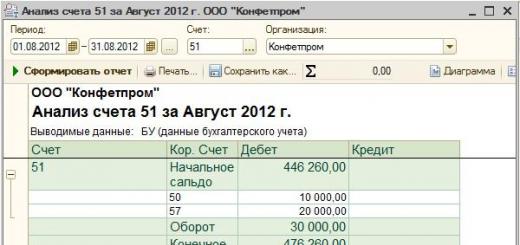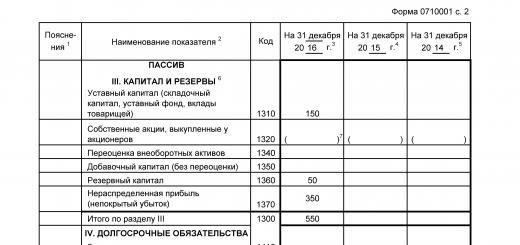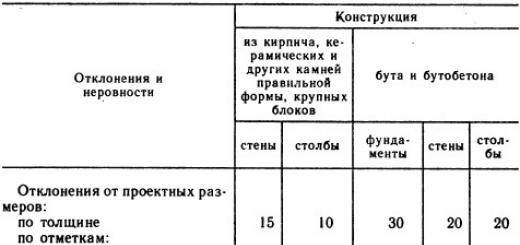Structural divisions of the bank
Branch- a separate subdivision located outside the location of the credit institution and carrying out on its behalf all or part of the banking operations provided for by the license of the Central Bank of the Russian Federation.
Representation- a separate subdivision located outside the location of the credit institution, representing its interests and protecting them. Has no right to carry out banking operations. It is not engaged in settlement, cash and credit services and does not have a correspondent sub-account.
Branches and representative offices of a credit institution are not legal entities.
Internal structural subdivision of the bank(open banks and branches) - a subdivision located outside the location of a credit institution (its branch) and carrying out banking operations on its behalf.
Internal structural subdivisions cannot have a separate balance sheet and open accounts for banking operations and other transactions.
Additional office carries out all or part of banking operations in accordance with the license. It cannot be located outside the territory subordinated to the territorial institution of the Central Bank of the Russian Federation, which supervises the activities of the bank.
Credit and cash office carries out operations to provide funds to small businesses and individuals and their return (repayment), as well as cash services for legal entities and individuals.
Operating cash desk outside the cash center provides only cash services to the population: accepting and issuing deposits, accepting utility and other payments from individuals, buying and selling securities.
Exchange office performs transactions for the sale and purchase of cash currency from individuals.
7. Procedure for state registration of banks and licensing of banking activities. (Art. 12-15 fz 395-1)
Banks are subject to state registration in accordance with the Federal Law "On State Registration of Legal Entities and Individual Entrepreneurs", subject to the provisions of the Federal Law "On Banks and Banking Activity". The decision on state registration of a bank is made by the Bank of Russia. Entering into the Unified State Register of Legal Entities information on the establishment of a bank is carried out by an authorized registering body. A state fee is charged for state registration. Banking license issued after the state registration of the bank.
For the state registration of a bank and obtaining a license to carry out banking activities, the following documents are submitted to the Bank of Russia:
business plan, minutes of the meeting of founders, containing decisions on the approval of the charter, as well as candidates for appointment to the positions of head and chief accountant;
documents confirming the payment of the state fee for state registration and for granting a license for banking operations;
audit reports on the reliability of the financial statements of the founders - legal entities;
documents confirming the sources of origin of funds contributed by founders - individuals to the authorized capital of a credit institution;
questionnaires of candidates for the positions of head, chief accountant, deputy chief accountant, head, chief accountant of the branch;
documents necessary for assessing the business reputation of founders (participants), candidates for members of the board of directors (supervisory board), a person exercising the functions of the sole executive body of a legal entity - a founder (participant) acquiring more than 10 percent of shares (stakes) in a credit institution.
application for state registration and issuance of a license for banking operations;
memorandum of association;
Procedure for state registration and licensing:
Upon submission of the said documents, the Bank of Russia shall issue a written confirmation of receipt of the documents.
A decision on state registration and issuance of a license or on refusal to do so is made within the time limit not exceeding six months from the date of submission of all required documents.
The Bank of Russia, after making a decision on state registration, sends to the authorized registering body the information and documents necessary for this body to carry out the functions of maintaining the Unified State Register of Legal Entities.
On the basis of this decision, the authorized registration body within the time no more than five working days from the date of receipt of information and documents, makes an appropriate entry in the Unified State Register of Legal Entities and no later than the working day following the day of entry, reports this to the Bank of Russia.
Bank of Russia no later than three working days from the date of receipt of information from the authorized registering body about the entry made in the Unified State Register of Legal Entities notifies its founders about this with a requirement to make within a month payment of 100 percent of the authorized capital and issues to the founders a document confirming the fact of making an entry about the bank in the Unified State Register of Legal Entities.
Non-payment or incomplete payment of the authorized capital within the established period is the basis for the Bank of Russia to go to court with a request to liquidate the bank.
To pay for the authorized capital, the Bank of Russia opens a correspondent account for a registered bank with the Bank of Russia.
Upon presentation of documents confirming the payment of 100 percent of the authorized capital of the bank, the Bank of Russia within three days issues a license to carry out banking operations.
A correctly chosen internal organizational structure, its timely transformation in accordance with changing circumstances are important, strictly mandatory conditions for the bank to implement its strategy and plans, its effective activities today and in the future.
The organizational structures of the internal structure of the bank with a certain degree of conditionality are divided into two large groups: classical and adaptive.
The classical (traditional) forms of organizational construction of banks include: functional units and services; divisional units and services.
Functional structures are more or less separate divisions (services) that implement functions in accordance with the division of all bank activities into main parts or industries, which are quite easy to distinguish meaningfully.
The functional type of organization of internal divisions for Russian (and not only Russian) banks can be considered traditional. This principle of organization, if carried out correctly and consistently, provides competitive advantages due to the deepening of specialization, clarity, reliability of communications, lack of duplication, which allows you to quickly make and implement the necessary management decisions.
Functionally organized departments and services of the bank, performing arrays of the same type of tasks, in turn, can be divided into subgroups:
the main (functional) divisions that perform tasks that constitute the very nature of banking, i.e. either directly creating banking products, providing relevant services to bank customers, or indirectly participating in the creation and sale of bank products. These include, for example, such divisions (departments, departments) as: passive operations; active operations; currency transactions; operations with securities; accounting and reporting; planned (planned-analytical); marketing, etc.;
supporting units that technologically do not participate in the main operations of the bank, performing tasks of an auxiliary, servicing nature, aimed at creating conditions for the reliable and efficient functioning of units of the first subgroup; these include subdivisions (departments, departments, departments, services): personnel (for work with personnel); regulatory and legal; security; information support; technical support; economic.
If the volumes of tasks solved by these (and not named here) divisions are large enough, then additional, smaller divisions can be created within them.
For example, the active operations division is in fact always represented by several divisions, the central of which is credit, but it is often divided into more subdivisions responsible for short- and medium-term lending individuals, as well as interbank lending) and long-term (investment) lending.
The management of the bank, taking into account its strategy, size, range of services provided and other factors, should choose what forms and in what combination to create for use in work and how to place them in the overall structure of the bank, as well as determine the principles and mechanisms of interaction between them.
Functional type units create the necessary conditions for maintaining a justified level of specialization of bank units and improving the quality of its services (although in most cases there is still no alternative to them). At the same time, this type of building organizational structures does not always make it possible to effectively coordinate the actions of departments in solving complex and “joint” problems of bank development. Such problems arise when banks try to actively and adequately respond to significant changes in the parameters of demand from the clientele for banking services (including in order to maintain and even expand the client base), as well as when introducing new banking products into practice, developing non-traditional services especially if they are complex. These kinds of problems can be solved by creating divisional and adaptive organizational structures.
As evidenced by the experience of domestic and foreign banks, the narrow internal specialization of departments can hinder the introduction of advanced banking technologies and improve the quality of customer service. With a functional organization, this leads to the fact that the client, in order to solve his problems, has to contact several banking departments, each of which operates only within its own area of competence. In such conditions, the process of providing a particular service to a client is discrete, takes a lot of time, and the client himself does not get a complete picture of all the available options for solving his problem and cannot navigate in choosing the best one.
The way out of this situation was the model of banking activity, focused on the results of marketing research. Its embodiment can be considered, in particular, the use of divisional units (services) focused on: the types of banking products sold (their packages); to the needs of individual customer groups.
It is advisable to create product-oriented divisions in cases where the bank sells to its customers very significant volumes of certain types of products (services) and without the allocation of a special division with its own special management, the effective implementation of such products becomes problematic. Depending on the circumstances of the development of a particular bank, the direction of its activity, which requires the allocation of a specialized unit, may be the production of any banking product.
In the developed case, a network of local divisions of the bank is allocated, each of which is intended to form a certain set (package) of services. Each package is assigned to a manager (a group of managers), who, together with a group of performers, participates in operational work, but has his own special task - to combine the consumer parameters of the service (service package) with the requirements of the client. At the same time, the manager's powers can be different: either he has only consultative and advisory powers, or he acts as a subject of linear management, endowed with appropriate rights and obligations.
The construction of divisions focused on certain groups of customers means a greater or lesser specialization of the bank in servicing certain segments of economic entities - pre-selected target groups, in providing these groups in the first place with the entire complex or individual banking products. Each customer service division serves one target group comprehensively.
Divisional organization involves the division of the bank into a number of large "divisions" or profitable centers. As a result, new large management objects appear inside the bank - a kind of mini-banks. Each of these centers in many ways resembles a specialized linear division, however, it has its own internal management (in the person of a special manager who must organize the management of the facility in such a way as to ensure its profitable operation), and profit is used as a criterion for the effectiveness of its functioning. The divisional version of the organization of bank divisions in Russian practice has not yet become widespread.
Organizational structures created by banks on a temporary or permanent basis to solve certain additional, auxiliary (at a given time) tasks are considered adaptive, allowing them to correctly respond to new processes in the economy, finance, and adapt to changing business conditions. These include: 1) project structures (special units created on a temporary basis for the implementation of large-scale projects, including joint investment projects); 2) divisions (services) created for the development and subsequent implementation of a new banking product to customers; 3) representations; 4) banking groups, associations, holdings; 5) financial and industrial groups with the participation of banks.
The last three types of organizational structures refer to the forms of external divisions of banks. This means that both internal and external units (services) can and should be adaptive.
The considered forms of internal divisions of banks, as a rule, are not alternative (mutually exclusive) in the strict sense of the word. Any bank in practice should use functional, divisional, and adaptive forms. Moreover, these concepts themselves are just theoretically distinguished forms that are convenient for analytical purposes, but which do not exist in real life and should not exist in a “pure form”.
The model of the organizational structure of each particular bank is a unique (with rare exceptions) combination of the above forms of units, depending both on the actual conditions of their functioning, and on many attendant circumstances. Thus, banks differ among themselves in size, level of specialization, clientele served, the structure of liabilities and many other characteristics. Various requirements are also imposed on their organizational structure. Different goals and objectives of the bank's development, the principles of management adopted in it and intentions to make changes to them, plans for adjusting specialization and many other reasons, in turn, can pose dilemmas in the choice of organizational options; structures. It is impossible to create an ideal banking structure that meets all possible requirements as much as possible. In a certain sense, the organizational structure of a bank is always a compromise.
INSTRUCTION of the Central Bank of the Russian Federation dated January 14, 2004 N 109-I (as amended on May 14, 2007) “On the procedure for the Bank of Russia to make a decision on the state registration of credit institutions and the issuance of licenses for banking operations”
OKVKU has the right to carry out cash transactions with legal entities and individuals, accept cash in the Russian Federation and foreign currency for transfers on behalf of an individual without opening a bank account, as well as certain types of banking operations and other transactions in cash foreign currency and the currency of the Russian Federation, checks ( including traveler's checks), the nominal value of which is indicated in foreign currency, established by paragraphs 3.1 and 3.2 of Instructions of the Bank of Russia N 113-I.
OKVKU may be located outside the territory subordinated to the territorial institution of the Bank of Russia, which supervises the activities of the relevant credit institution (branch).
In order to provide cash services to individuals and legal entities, as well as to perform operations with cash and other valuables, a credit institution creates cash register. It is created in a building occupied by a credit institution on the basis of ownership or lease. The cash point must be equipped in accordance with the Requirements for the arrangement and technical strength of the cash point in the building of a credit institution.
A credit institution is obliged to timely issue money from bank accounts. Therefore, the Bank of Russia sets the amount of the minimum allowable cash balance in the operating cash desk at the end of the day. This cash balance in the operating cash desk is established by the institution, taking into account the volume of cash turnover that passes through the cash desk. In addition, the schedule of receipt of cash from customers, the procedure for its processing and other features of the organization of cash circulation and cash work are taken into account. As necessary, the minimum allowable cash balance in the operating cash desk at the end of the day may be reviewed by the credit institution in the prescribed manner.
When performing cash transactions, credit institutions may use software and hardware, machines for receiving and dispensing cash to customers, including using a personal computer installed at the workplace of a cash worker (hereinafter referred to as an electronic cashier), terminals operating in automatic mode and designed to receive cash from customers and store it (hereinafter referred to as an automatic safe), ATMs and other software and hardware systems. Types (models) of software and hardware equipment, electronic cashiers, automatic safes, ATMs and other software and hardware systems are determined by the credit institution.
The direct execution of operations with cash is carried out by cashiers and collectors. The operations performed by these employees are determined by the functional duties assigned to them by the ordering document of the credit institution.
In order to improve the quality of services for organizations, as well as the convenience and speed of servicing the population, a credit institution may open operating cash desks outside the cash center . Such cash desks are opened to carry out operations for accepting and issuing deposits (in rubles and foreign currency), selling and buying securities, and accepting utility and other payments from individuals. If these cash desks are outside the cash desk, located in organizations, then they produce, in addition to the above operations, the issuance of funds for wages and social payments, as well as for travel expenses for workers and employees.
It should be borne in mind that operating cash desks outside the cash center of a credit institution perform only those of the above operations for which the credit institution has a license, and the branch has a power of attorney. However, such an arrangement of the cash desk does not mean that less requirements can be made to it in terms of its structure and technical strength.
When opening an operating cash desk outside a cash point, a credit institution shall notify the territorial office of the Bank of Russia at the location of the credit institution, as well as at the place where the operating cash desk is opened. The Notice shall indicate the name of the credit institution, its registration number, last names, first names, patronymics and telephone numbers of the head and chief accountant of the credit institution, the postal address of the location of the operating cash desk, telephone, fax, the ownership of the premises, the list of operations performed by the specified cash desk, the date of notification. This is done for the purpose of timeliness of banking supervision. Having received such a notification, the territorial branch of the Bank of Russia checks for compliance of the actual device of the cash desk and its technical strength with the requirements and gives its opinion.
Internal structural subdivisions of a credit institution (branch) may not have a separate balance sheet and open accounts for banking operations and other transactions, except as provided for by Bank of Russia regulations. Internal structural subdivisions of a credit institution (branch) carry out operations in the manner prescribed by Bank of Russia regulations.
Operations carried out by internal structural units of a credit institution (branch) must be reflected in the daily balance sheet of the credit institution (branch) (Regulation of the Bank of Russia dated December 5, 2002 N 205-P "On the rules for maintaining accounting in credit institutions located in the territory of the Russian Federation" ).
Accounting and storage of primary accounting documents and processing of accounting documentation generated in the activities of internal structural divisions is carried out in accordance with the requirements of federal laws, Bank of Russia regulations and internal documents of the credit institution.
Additional office shall be entitled to carry out all or part of the banking operations provided for by the license issued to the credit institution for banking operations (regulations on the branch).
Additional office cannot be located outside the territory, subordinated to the territorial institution of the Bank of Russia, which supervises the activities of the relevant credit institution (branch).
Peculiarities of opening (closing) and activities of additional offices may be established by other Bank of Russia regulations.
Operational office may be located both on the territory under the jurisdiction of the territorial institution of the Bank of Russia that supervises the activities of the credit institution (branch) opening an operational office, and outside such territory within the federal district on the territory of which the head office of the credit institution (branch) opening operational office.
The operational office has the right to carry out all or part of the banking operations provided for by the license issued to the credit institution for banking operations (the regulation on the branch).
An operational office located outside the territory subordinate to the territorial institution of the Bank of Russia supervising the activities of a credit institution (branch) within the federal district on whose territory the head office of the credit institution (branch) opening operating office, not entitled :
- carry out transactions (including transactions at the expense of customers) for the purchase and (or) sale of foreign currency both in cash and in a non-cash form on the interbank and exchange currency markets;
- carry out transactions (including transactions at the expense of customers) for the purchase and (or) sale of securities and other financial assets associated with the assumption of financial risks by a credit institution (including credit and market risks), except for transactions associated with the assumption of credit risk per the borrower in the amount of less than 5 percent of the own funds (capital) of the credit institution. At the same time, transactions related to the acceptance of credit risk per borrower in the amount equal to or exceeding 5 percent of the credit institution's own funds (capital) concluded by the credit institution (branch) may be transferred to the operating office for servicing;
- provide loans (credits) to credit institutions, as well as place deposits and other funds with credit institutions;
- receive loans (credits), attract deposits and other funds from credit institutions;
- open and maintain correspondent accounts of credit institutions (branches);
- open correspondent accounts with credit institutions (branches) for transactions;
- issue bank guarantees;
- carry out acceptance and (or) avalization of bills of exchange.
The internal structural divisions of a credit organization include: additional, operating and credit and cash offices, operating cash desks outside the cash center.
The procedure for opening bank branches is regulated by:
Article 22 "Branches, Representative Offices and Internal Structural Subdivisions of a Credit Institution" of the Federal Law "On Banks and Banking Activities";
Instruction of the Central Bank of the Russian Federation dated April 2, 2010 No. 135-I (previously - No. 109-I dated January 14, 2004) "On the procedure for the Bank of Russia to make a decision on the state registration of credit institutions and the issuance of licenses for banking operations" (hereinafter - Instruction No. 135-I)
Additional office- an internal structural subdivision of the bank or its branch. May carry out banking operations or part of them, provided for by the license of the Central Bank for the credit institution or branch that created it. It opens only on the territory of the same locality where the bank itself or its branch is located.
Credit and cash office- an internal structural subdivision of the bank or its branch. Carries out operations for the provision of funds to small businesses and individuals and their return (repayment), as well as cash services for legal entities and individuals. Such a definition can be found in Instructions of the Bank of Russia No. 135-I.
Operating cash desk outside the cash center- an internal structural subdivision of the bank, which provides only cash services to the population: accepting and issuing deposits, accepting utility and other payments from individuals, buying and selling securities (Instruction No. 135-I).
By Decree No. 1794-U dated February 21, 2007, the Bank of Russia gave credit institutions the right to open a new type of internal structural unit - an operational office.
The office can carry out all or part of the banking operations provided for by the license of the Central Bank for the financial institution (branch) that created it. Subdivisions located outside the territory of the institution of the Bank of Russia, which controls the activities of a credit institution (branch), have a number of restrictions on the implementation of operations. For example, they are not entitled to carry out operations for the purchase and sale of foreign currency in the interbank and exchange currency markets, securities and other financial assets associated with the bank's taking financial risks, etc.
Unlike an additional office, operating cash desks outside the cash node, credit and cash and operating offices may be located outside the department of the territorial institution of the Bank of Russia, which supervises the activities of the bank (branch) that opened this unit.
It should also be noted that, in accordance with the instructions of the Central Bank No. 2423-U, since October 1, 2010, all exchange offices have been transferred to the status of internal structural units (with the exception of the mobile point of cash transactions) or closed.
Structural divisions of the bank
In Russia, credit institutions have the right to open separate subdivisions - representative offices and branches, as well as internal structural subdivisions - additional, operational and credit and cash offices, operating cash desks outside the cash desk.
Separate subdivisions are opened by notifying the Bank of Russia and must be specified in the charter of the credit institution. They are not legal entities. The management is appointed by the bank, and the branch will be able to exercise only after the candidates for the positions of managers are agreed with the Central Bank.
Internal structural divisions of a credit institution do not have a separate balance sheet and cannot open accounts for banking operations. All operations carried out by them are reflected in the daily balance sheet of the bank or its branch.
Information about the location of its internal divisions is not indicated by the bank in the charter. He sends such information to the relevant territorial institutions of the Bank of Russia.
The appointment of the heads of internal divisions of the bank is made by the credit institution (branch) itself and does not require approval from the Bank of Russia. The name of such a subdivision must contain an indication of its type and affiliation with a particular credit institution (branch).
As of June 2011, Sberbank has the largest branch network. It has 531 branches, 10,263 additional offices, 256 operating offices, 8,146 non-cash operating cash desks.
See what "Structural divisions of the bank" is in other dictionaries:
The internal structural divisions of a credit institution include: additional, operating and credit-cash offices, operating cash desks outside the cash center. The procedure for opening banking units is regulated by: article 22 ... ... Banking Encyclopedia
Settlement divisions of the Bank of Russia- territorial institutions of the Bank of Russia and structural subdivisions of the Bank of Russia (GTU of the Central Bank of the Russian Federation, National Banks of the Bank of Russia, OPERA of the Central Bank of the Russian Federation, TsOU of the Central Bank of the Russian Federation), which are authorized by the Bank of Russia to carry out cash settlements following the results of trading ... ... Depository terms
Settlement divisions of the Central Bank of the Russian Federation- Settlement divisions of the Bank of Russia, territorial branches of the Bank of Russia and structural divisions of the Bank of Russia (GTU, NB, OPERU 1 of the Bank of Russia), which are authorized by the Bank of Russia to carry out cash settlements based on the results of operations on the OSM in ... ... Official terminology
- - a unified vertical management system of the Central Bank of the Russian Federation. It includes the central office, territorial offices, cash settlement centers, computer centers, field institutions, educational institutions, security units, the Russian ... ... Banking Encyclopedia
They are separate divisions. The representative office protects the interests of the bank in a certain territory, but does not have the right to carry out banking operations. The number of representative offices opened by the financial institution is unlimited. Branch … Banking Encyclopedia
- - specialized structural divisions of the Central Bank, which are military institutions. They are guided in their activities by the charters and regulations on field institutions of the Bank of Russia, approved by a joint decision of the Central Bank of the Russian Federation and ... ... Banking Encyclopedia
Associated participant of settlements of the system of banking electronic urgent payments (BESP)- 2.4.3. An associated settlement participant (hereinafter referred to as ASP) is a credit institution (its branch) included in the Directory of BESP system participants, which has the opportunity to use the services of the BESP system provided for by the rules for ASP ... ... Official terminology
Every year, the Pension Fund of the Russian Federation (PFR) informs the participants in the mandatory pension insurance system about the status of their individual accounts through letters sent to them. If a citizen needs information about the state of his ... ... Banking Encyclopedia
TERRITORIAL BODIES OF THE FEDERAL TREASURY OF THE RUSSIAN FEDERATION- Structural divisions of the unified centralized system of bodies of the Federal Treasury of the Ministry of Finance of the Russian Federation. These include territory. management of the Federal Treasury in the republics within the Russian Federation, territories, regions, autonomous ... ... Financial and Credit Encyclopedic Dictionary
Standard Bank- (Standert Bank) Information about Standard Bank, assets and branches Information about Standard Bank, bank development, new goals Encyclopedia of the investor










